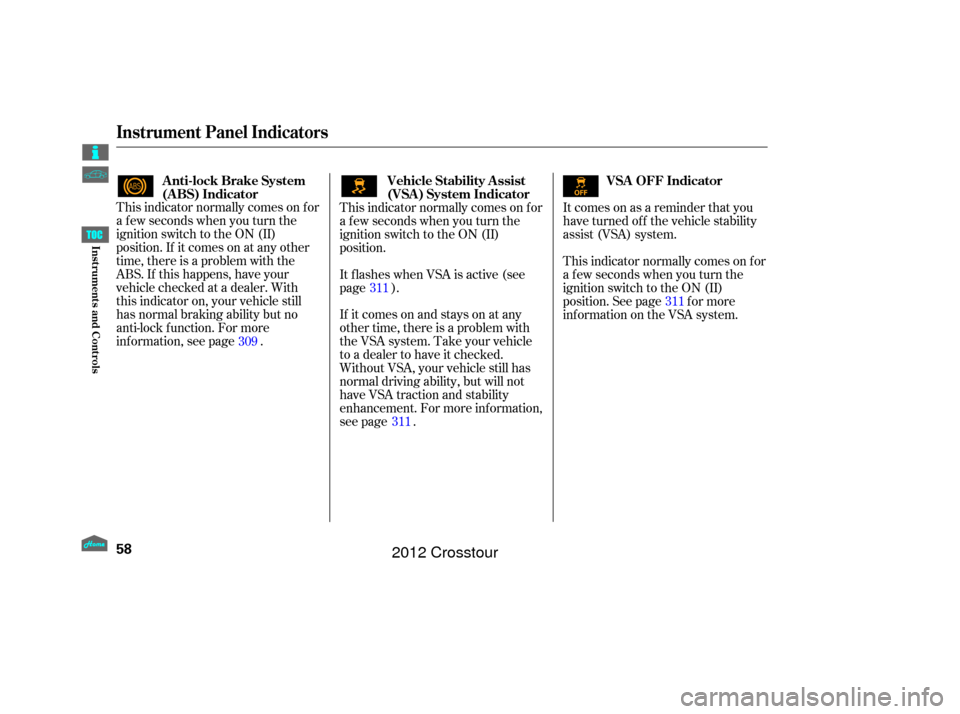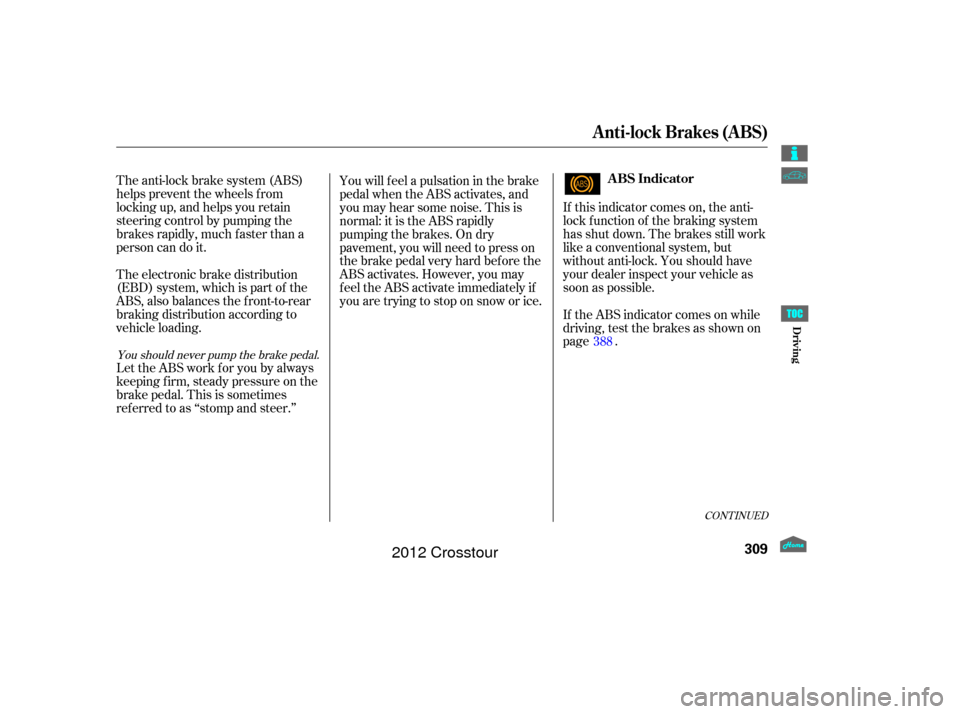Page 59 of 435

The U.S. instrument panel is shown. Dif f erences f or the Canadian models are noted in the text.
Instrument Panel
55
LOW FUEL INDICATOR
ANTI-LOCK BRAKE SYSTEM
(ABS) INDICATOR
LIGHTS ON INDICATOR
CRUISE CONTROL
INDICATOR
(P.61)
(P. 57)
(P.58)
(P.
62)
CRUISE CONTROL
MAIN INDICATOR
(P.
62)
(P.56) (P.
60)
(P.59)
(P.61)
HIGH BEAM INDICATOR
MAINTENANCE MINDER INDICATOR (P.62) (P.60)
TIRE PRESSURE MONITORING
SYSTEM (TPMS) INDICATOR (P.59)
DAYTIME RUNNING LIGHTS INDICATOR (P.61
)
PARKING BRAKE AND BRAKE SYSTEM INDICATOR (P.57)
(P.58) FUEL ECONOMY INDICATOR (P.59) SIDE AIRBAG OFF INDICATOR
LOW TIRE PRESSURE
INDICATOR
SEAT BELT REMINDER
INDICATOR
DOOR AND TAILGATE OPEN INDICATOR
MALFUNCTION INDICATOR LAMP SECURITY SYSTEM INDICATOR
CHARGING SYSTEM INDICATOR
LOW OIL PRESSURE INDICATOR
IMMOBILIZER SYSTEM
INDICATOR (P.62) (P.61)
VEHICLE STABILITY ASSIST (VSA) SYSTEM
INDICATOR VSA OFF INDICATOR (P.58)
SUPPLEMENTAL RESTRAINT
SYSTEM (SRS) INDICATOR (P.57)
(P.56,
386)
(P.56, 386)
(P.56,387) FOG LIGHT INDICATOR (P.62)
Inst rument s and Cont rols
2012 Crosstour
Page 62 of 435

This indicator normally comes on f or
a f ew seconds when you turn the
ignition switch to the ON (II)
position. If it comes on at any other
time, there is a problem with the
ABS. If this happens, have your
vehicle checked at a dealer. With
this indicator on, your vehicle still
has normal braking ability but no
anti-lock f unction. For more
inf ormation, see page .This indicator normally comes on f or
a f ew seconds when you turn the
ignition switch to the ON (II)
position.
It flashes when VSA is active (see
page ).
If itcomesonandstaysonatany
other time, there is a problem with
the VSA system. Take your vehicle
to a dealer to have it checked.
Without VSA, your vehicle still has
normal driving ability, but will not
have VSA traction and stability
enhancement. For more inf ormation,
see page .Itcomesonasareminderthatyou
have turned off the vehicle stability
assist (VSA) system.
This indicator normally comes on f or
a f ew seconds when you turn the
ignition switch to the ON (II)
position. See page f or more
inf ormation on the VSA system.
309 311
311
311
Instrument Panel Indicators
Vehicle Stability Assist
(VSA ) System Indicator
Anti-lock Brake System
(A BS) Indicator VSA OFF Indicator
58
Inst rument s and Cont rols
2012 Crosstour
Page 137 of 435
The airf low f rom the rear vents can
be adjusted when the AUTO mode is
selected or the f an mode is in theor position.
You can adjust the direction of the
airflowbymovingthetaboneach
vent up-and-down and side-to-side.
You can also open or close the vents
with the dial between them. Theclimatecontrolsystemhastwo
sensors: a sunlight sensor on top of
the dashboard, and a temperature
and humidity sensor next to the
steering column. Do not cover the
sensors or spill any liquid on them. Sunlight Sensor/
Temperature Sensor
Rear Ventilation
Climate Control System
133
SUNLIGHT SENSOR TEMPERATURE SENSOR
Open
DIAL
CloseTABS
REAR VENTS
Features
2012 Crosstour
Page 287 of 435

CONT INUED
For f urther important f uel-related
inf ormation f or your vehicle, or
inf ormation on gasoline that does not
contain MMT, visit Owner Link at. In Canada, visit
f or additional
inf ormation on gasoline.
Because the level of detergency and
additives in gasoline vary in the
market, Honda endorses the use of
‘‘TOP TIER Detergent Gasoline’’
where available to help maintain the
perf ormance and reliability of your
vehicle. TOP TIER Detergent
Gasoline meets a new gasoline
standard jointly established by
leading automotive manuf acturers to
meet the needs of today’s advanced
engines. Qualif ying gasoline retailers
will, in most cases, identif y their
gasoline as having met ‘‘TOP TIER
Detergent Gasoline’’ standards at the
retail location. This f uel is
guaranteed to contain the proper
level of detergent additives and be
f ree of metallic additives. The proper
level of detergent additives, and
absence of harmf ul metallic additives
in gasoline, help avoid build-up of
deposits in your engine and emission
control system.
Use of gasoline with these additives
may adversely af f ect perf ormance,
and cause the malfunction indicator
lamp on your instrument panel to
come on. If this happens, contact
your dealer f or service. Some
gasoline today is blended with
oxygenates such as ethanol. Your
vehicle is designed to operate on
oxygenated gasoline containing up to
10% ethanol by volume. Do not use
gasoline containing methanol. If you
notice any undesirable operating
symptoms, try another service
station or switch to another brand of
gasoline.
owners.honda.com
www.honda.ca
Fuel Recommendation, Service Station Procedures
283
Bef ore Driving
2012 Crosstour
Page 303 of 435
........................
Preparing to Drive .300
.......................
Starting the Engine .301
..............
Automatic Transmission . 302
...........................................
Parking .307
.............................
Braking System .308
...............
Anti-lock Brakes (ABS) . 309
Vehicle Stability Assist (VSA
),
aka Electronic Stability Control .......................
(ESC), System .311
Tire Pressure Monitoring ........................
System (TPMS) .313
...........................
Towing a Trailer .316
This section gives you tips on
starting the engine under various
conditions, and how to operate the
automatic transmission. It also
includes important inf ormation on
parking your vehicle, the braking
system, the vehicle stability assist
(VSA
) system, the tire pressure
monitoring system (TPMS), and
f acts you need if you are planning to
tow a trailer.
Driving
Driving
299
2012 Crosstour
Page 312 of 435

The hydraulic system that operates
the brakes has two separate circuits.
Each circuit works diagonally across
the vehicle (the lef t-f ront brake is
connected with the right-rear brake,
etc.). If one circuit should develop a
problem, you will still have braking
at two wheels.
Your vehicle is equipped with disc
brakes at all f our wheels. A power
assist helps reduce the ef f ort needed
on the brake pedal. The emergency
brake assist system increases the
stopping f orce when you depress the
brake pedal hard in an emergency
situation. The anti-lock brake system
(ABS) helps you retain steering
control when braking very hard.
Resting your f oot on the pedal keeps
the brakes applied lightly, builds up
heat, reduces their ef f ectiveness and
reduces brake pad lif e. In addition,
f uel economy can be reduced. It also
keeps your brake lights on all the
time, conf using drivers behind you. Check the brakes after driving
through deep water. Apply the
brakes moderately to see if they f eel
normal. If not, apply them gently and
f requently until they do. Be extra
cautious in your driving. Constant application of the brakes
when going down a long hill builds
up heat and reduces their ef f ective-
ness. Use the engine to assist the
brakes by taking your f oot of f the
accelerator and downshif ting to a
lower gear.
The f ront and rear disc brakes on all
models have audible brake pad wear
indicators.
If the brake pads need replacing, you
will hear a distinctive, metallic
screeching sound when you apply
the brake pedal. If you do not have
the brake pads replaced, they will
screech all the time. It is normal f or
the brakes to occasionally squeal or
squeak when you apply them. Braking System Design
Brake Pad Wear Indicators
Braking System
308
Driving
2012 Crosstour
Page 313 of 435

If this indicator comes on, the anti-
lock f unction of the braking system
has shut down. The brakes still work
like a conventional system, but
without anti-lock. You should have
your dealer inspect your vehicle as
soon as possible.
The anti-lock brake system (ABS)
helpspreventthewheelsfrom
locking up, and helps you retain
steering control by pumping the
brakes rapidly, much f aster than a
person can do it.
You will f eel a pulsation in the brake
pedal when the ABS activates, and
you may hear some noise. This is
normal: it is the ABS rapidly
pumpingthebrakes.Ondry
pavement, you will need to press on
thebrakepedalveryhardbeforethe
ABS activates. However, you may
feel the ABS activate immediately if
you are trying to stop on snow or ice.
The electronic brake distribution
(EBD) system, which is part of the
ABS, also balances the f ront-to-rear
braking distribution according to
vehicle loading.
Let the ABS work f or you by always
keeping f irm, steady pressure on the
brake pedal. This is sometimes
ref erred to as ‘‘stomp and steer.’’ If the ABS indicator comes on while
driving, test the brakes as shown on
page .
388
You should never pump the brake pedal.
CONT INUED
ABS Indicator
Anti-lock Brakes (ABS)
309
Driving
2012 Crosstour
Page 314 of 435

It only helps with the
steering control during braking.
such as trying to take a
corner too f ast or making a sudden
lane change. Always drive at a safe
speed f or the road and weather
conditions.
Always steer moderately
when you are braking hard. Severe
or sharp steering wheel movement
can still cause your vehicle to veer
into oncoming traffic or off the road. on loose or
uneven surf aces, such as gravel or
snow, than a vehicle without anti-
lock.
Test your brakes as instructed on
page . If the brakes f eel normal,
drive slowly and have your vehicle
repaired by your dealer as soon as
possible. Avoid sudden hard braking
which could cause the rear wheels to
lock up and possibly lead to a loss of
control. If the ABS indicator and the brake
system indicator come on together,
and the parking brake is f ully
released, the EBD system may also
be shut down.
388 A BS does not reduce the time or
distance it takes to stop the
vehicle.
A BS will not prevent a skid that
results f rom changing direction
abruptly,
A BS cannot prevent a loss of
stability. A vehicle with A BS may require a
longer distance to stop
Import ant Saf et y Reminders
Anti-lock Brakes (ABS)
310
Driving
2012 Crosstour